QA Higher Education Freshers Party: Project Management Report Analysis
VerifiedAdded on 2021/02/19
|13
|3415
|63
Report
AI Summary
This report analyzes the project management aspects of a Freshers Party organized by QA Higher Education, focusing on event planning and execution. The report includes a project initiation document outlining the budget, timescale, objectives, and approach. It also features a work breakdown structure (WBS) that details the tasks involved in organizing the event, from objective creation to post-event evaluation. A risk register identifies potential risks and mitigation strategies, and the report explores the application of the waterfall and PRINCE2 methodologies. Furthermore, the report includes a stakeholder analysis, categorizing stakeholders based on their power and interest, and evaluating their influence on the event's success. Overall, the report provides a comprehensive overview of the project management processes used to organize the Freshers Party, highlighting the key elements that contributed to its planning, execution, and potential challenges.

Project Management
Paraphrase This Document
Need a fresh take? Get an instant paraphrase of this document with our AI Paraphraser
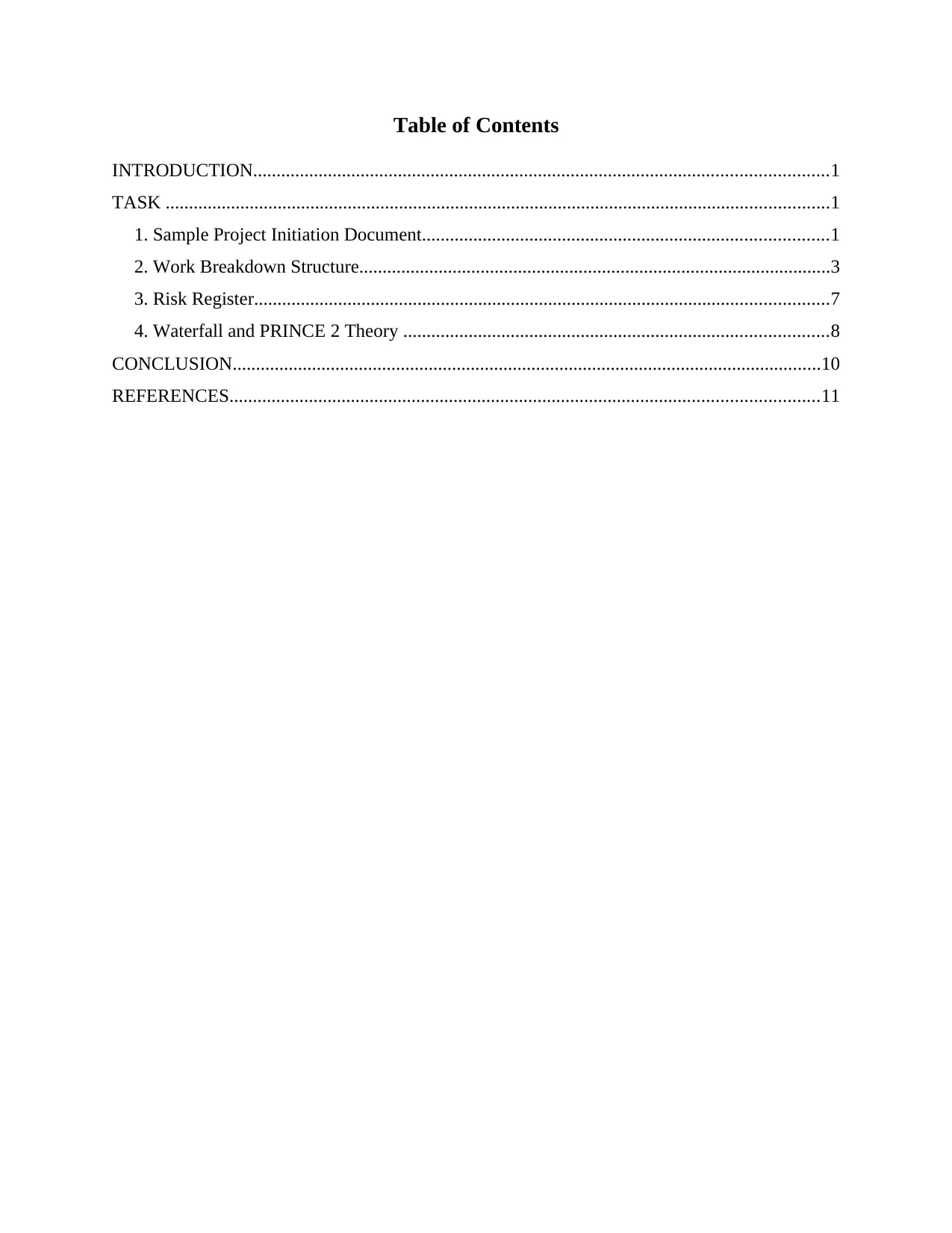
Table of Contents
INTRODUCTION...........................................................................................................................1
TASK ..............................................................................................................................................1
1. Sample Project Initiation Document.......................................................................................1
2. Work Breakdown Structure.....................................................................................................3
3. Risk Register...........................................................................................................................7
4. Waterfall and PRINCE 2 Theory ...........................................................................................8
CONCLUSION..............................................................................................................................10
REFERENCES..............................................................................................................................11
INTRODUCTION...........................................................................................................................1
TASK ..............................................................................................................................................1
1. Sample Project Initiation Document.......................................................................................1
2. Work Breakdown Structure.....................................................................................................3
3. Risk Register...........................................................................................................................7
4. Waterfall and PRINCE 2 Theory ...........................................................................................8
CONCLUSION..............................................................................................................................10
REFERENCES..............................................................................................................................11
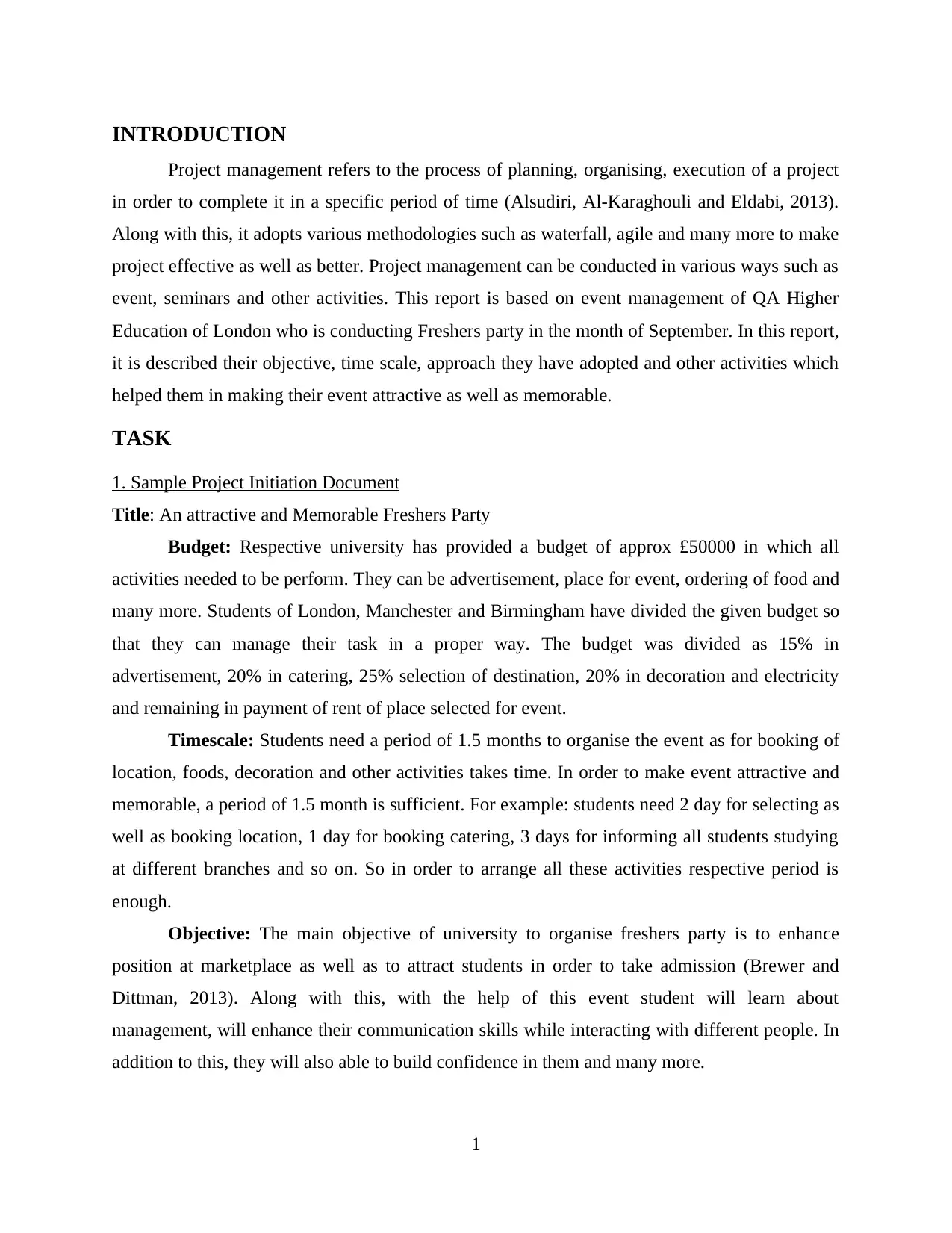
INTRODUCTION
Project management refers to the process of planning, organising, execution of a project
in order to complete it in a specific period of time (Alsudiri, Al-Karaghouli and Eldabi, 2013).
Along with this, it adopts various methodologies such as waterfall, agile and many more to make
project effective as well as better. Project management can be conducted in various ways such as
event, seminars and other activities. This report is based on event management of QA Higher
Education of London who is conducting Freshers party in the month of September. In this report,
it is described their objective, time scale, approach they have adopted and other activities which
helped them in making their event attractive as well as memorable.
TASK
1. Sample Project Initiation Document
Title: An attractive and Memorable Freshers Party
Budget: Respective university has provided a budget of approx £50000 in which all
activities needed to be perform. They can be advertisement, place for event, ordering of food and
many more. Students of London, Manchester and Birmingham have divided the given budget so
that they can manage their task in a proper way. The budget was divided as 15% in
advertisement, 20% in catering, 25% selection of destination, 20% in decoration and electricity
and remaining in payment of rent of place selected for event.
Timescale: Students need a period of 1.5 months to organise the event as for booking of
location, foods, decoration and other activities takes time. In order to make event attractive and
memorable, a period of 1.5 month is sufficient. For example: students need 2 day for selecting as
well as booking location, 1 day for booking catering, 3 days for informing all students studying
at different branches and so on. So in order to arrange all these activities respective period is
enough.
Objective: The main objective of university to organise freshers party is to enhance
position at marketplace as well as to attract students in order to take admission (Brewer and
Dittman, 2013). Along with this, with the help of this event student will learn about
management, will enhance their communication skills while interacting with different people. In
addition to this, they will also able to build confidence in them and many more.
1
Project management refers to the process of planning, organising, execution of a project
in order to complete it in a specific period of time (Alsudiri, Al-Karaghouli and Eldabi, 2013).
Along with this, it adopts various methodologies such as waterfall, agile and many more to make
project effective as well as better. Project management can be conducted in various ways such as
event, seminars and other activities. This report is based on event management of QA Higher
Education of London who is conducting Freshers party in the month of September. In this report,
it is described their objective, time scale, approach they have adopted and other activities which
helped them in making their event attractive as well as memorable.
TASK
1. Sample Project Initiation Document
Title: An attractive and Memorable Freshers Party
Budget: Respective university has provided a budget of approx £50000 in which all
activities needed to be perform. They can be advertisement, place for event, ordering of food and
many more. Students of London, Manchester and Birmingham have divided the given budget so
that they can manage their task in a proper way. The budget was divided as 15% in
advertisement, 20% in catering, 25% selection of destination, 20% in decoration and electricity
and remaining in payment of rent of place selected for event.
Timescale: Students need a period of 1.5 months to organise the event as for booking of
location, foods, decoration and other activities takes time. In order to make event attractive and
memorable, a period of 1.5 month is sufficient. For example: students need 2 day for selecting as
well as booking location, 1 day for booking catering, 3 days for informing all students studying
at different branches and so on. So in order to arrange all these activities respective period is
enough.
Objective: The main objective of university to organise freshers party is to enhance
position at marketplace as well as to attract students in order to take admission (Brewer and
Dittman, 2013). Along with this, with the help of this event student will learn about
management, will enhance their communication skills while interacting with different people. In
addition to this, they will also able to build confidence in them and many more.
1
⊘ This is a preview!⊘
Do you want full access?
Subscribe today to unlock all pages.

Trusted by 1+ million students worldwide
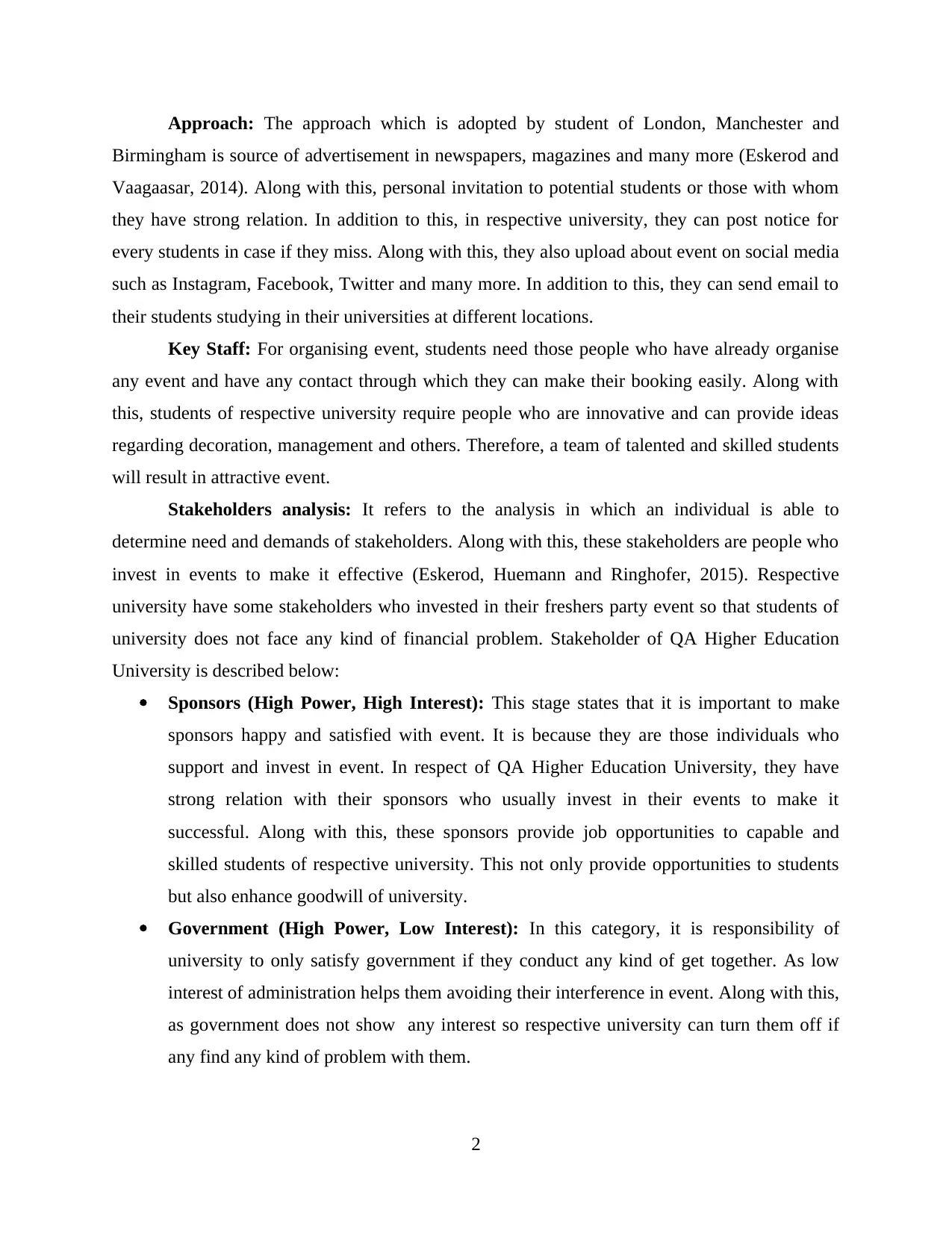
Approach: The approach which is adopted by student of London, Manchester and
Birmingham is source of advertisement in newspapers, magazines and many more (Eskerod and
Vaagaasar, 2014). Along with this, personal invitation to potential students or those with whom
they have strong relation. In addition to this, in respective university, they can post notice for
every students in case if they miss. Along with this, they also upload about event on social media
such as Instagram, Facebook, Twitter and many more. In addition to this, they can send email to
their students studying in their universities at different locations.
Key Staff: For organising event, students need those people who have already organise
any event and have any contact through which they can make their booking easily. Along with
this, students of respective university require people who are innovative and can provide ideas
regarding decoration, management and others. Therefore, a team of talented and skilled students
will result in attractive event.
Stakeholders analysis: It refers to the analysis in which an individual is able to
determine need and demands of stakeholders. Along with this, these stakeholders are people who
invest in events to make it effective (Eskerod, Huemann and Ringhofer, 2015). Respective
university have some stakeholders who invested in their freshers party event so that students of
university does not face any kind of financial problem. Stakeholder of QA Higher Education
University is described below:
Sponsors (High Power, High Interest): This stage states that it is important to make
sponsors happy and satisfied with event. It is because they are those individuals who
support and invest in event. In respect of QA Higher Education University, they have
strong relation with their sponsors who usually invest in their events to make it
successful. Along with this, these sponsors provide job opportunities to capable and
skilled students of respective university. This not only provide opportunities to students
but also enhance goodwill of university.
Government (High Power, Low Interest): In this category, it is responsibility of
university to only satisfy government if they conduct any kind of get together. As low
interest of administration helps them avoiding their interference in event. Along with this,
as government does not show any interest so respective university can turn them off if
any find any kind of problem with them.
2
Birmingham is source of advertisement in newspapers, magazines and many more (Eskerod and
Vaagaasar, 2014). Along with this, personal invitation to potential students or those with whom
they have strong relation. In addition to this, in respective university, they can post notice for
every students in case if they miss. Along with this, they also upload about event on social media
such as Instagram, Facebook, Twitter and many more. In addition to this, they can send email to
their students studying in their universities at different locations.
Key Staff: For organising event, students need those people who have already organise
any event and have any contact through which they can make their booking easily. Along with
this, students of respective university require people who are innovative and can provide ideas
regarding decoration, management and others. Therefore, a team of talented and skilled students
will result in attractive event.
Stakeholders analysis: It refers to the analysis in which an individual is able to
determine need and demands of stakeholders. Along with this, these stakeholders are people who
invest in events to make it effective (Eskerod, Huemann and Ringhofer, 2015). Respective
university have some stakeholders who invested in their freshers party event so that students of
university does not face any kind of financial problem. Stakeholder of QA Higher Education
University is described below:
Sponsors (High Power, High Interest): This stage states that it is important to make
sponsors happy and satisfied with event. It is because they are those individuals who
support and invest in event. In respect of QA Higher Education University, they have
strong relation with their sponsors who usually invest in their events to make it
successful. Along with this, these sponsors provide job opportunities to capable and
skilled students of respective university. This not only provide opportunities to students
but also enhance goodwill of university.
Government (High Power, Low Interest): In this category, it is responsibility of
university to only satisfy government if they conduct any kind of get together. As low
interest of administration helps them avoiding their interference in event. Along with this,
as government does not show any interest so respective university can turn them off if
any find any kind of problem with them.
2
Paraphrase This Document
Need a fresh take? Get an instant paraphrase of this document with our AI Paraphraser
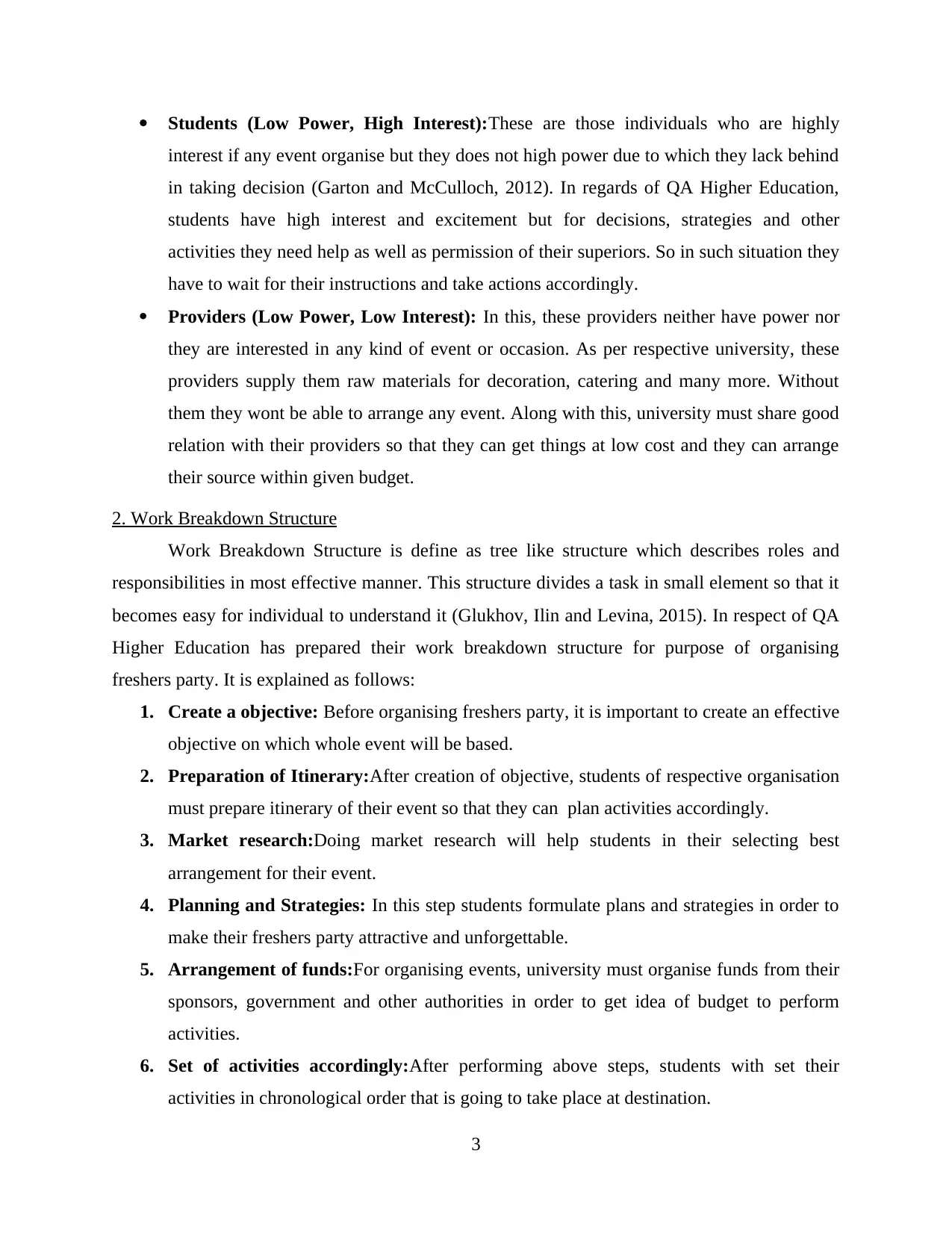
Students (Low Power, High Interest):These are those individuals who are highly
interest if any event organise but they does not high power due to which they lack behind
in taking decision (Garton and McCulloch, 2012). In regards of QA Higher Education,
students have high interest and excitement but for decisions, strategies and other
activities they need help as well as permission of their superiors. So in such situation they
have to wait for their instructions and take actions accordingly.
Providers (Low Power, Low Interest): In this, these providers neither have power nor
they are interested in any kind of event or occasion. As per respective university, these
providers supply them raw materials for decoration, catering and many more. Without
them they wont be able to arrange any event. Along with this, university must share good
relation with their providers so that they can get things at low cost and they can arrange
their source within given budget.
2. Work Breakdown Structure
Work Breakdown Structure is define as tree like structure which describes roles and
responsibilities in most effective manner. This structure divides a task in small element so that it
becomes easy for individual to understand it (Glukhov, Ilin and Levina, 2015). In respect of QA
Higher Education has prepared their work breakdown structure for purpose of organising
freshers party. It is explained as follows:
1. Create a objective: Before organising freshers party, it is important to create an effective
objective on which whole event will be based.
2. Preparation of Itinerary:After creation of objective, students of respective organisation
must prepare itinerary of their event so that they can plan activities accordingly.
3. Market research:Doing market research will help students in their selecting best
arrangement for their event.
4. Planning and Strategies: In this step students formulate plans and strategies in order to
make their freshers party attractive and unforgettable.
5. Arrangement of funds:For organising events, university must organise funds from their
sponsors, government and other authorities in order to get idea of budget to perform
activities.
6. Set of activities accordingly:After performing above steps, students with set their
activities in chronological order that is going to take place at destination.
3
interest if any event organise but they does not high power due to which they lack behind
in taking decision (Garton and McCulloch, 2012). In regards of QA Higher Education,
students have high interest and excitement but for decisions, strategies and other
activities they need help as well as permission of their superiors. So in such situation they
have to wait for their instructions and take actions accordingly.
Providers (Low Power, Low Interest): In this, these providers neither have power nor
they are interested in any kind of event or occasion. As per respective university, these
providers supply them raw materials for decoration, catering and many more. Without
them they wont be able to arrange any event. Along with this, university must share good
relation with their providers so that they can get things at low cost and they can arrange
their source within given budget.
2. Work Breakdown Structure
Work Breakdown Structure is define as tree like structure which describes roles and
responsibilities in most effective manner. This structure divides a task in small element so that it
becomes easy for individual to understand it (Glukhov, Ilin and Levina, 2015). In respect of QA
Higher Education has prepared their work breakdown structure for purpose of organising
freshers party. It is explained as follows:
1. Create a objective: Before organising freshers party, it is important to create an effective
objective on which whole event will be based.
2. Preparation of Itinerary:After creation of objective, students of respective organisation
must prepare itinerary of their event so that they can plan activities accordingly.
3. Market research:Doing market research will help students in their selecting best
arrangement for their event.
4. Planning and Strategies: In this step students formulate plans and strategies in order to
make their freshers party attractive and unforgettable.
5. Arrangement of funds:For organising events, university must organise funds from their
sponsors, government and other authorities in order to get idea of budget to perform
activities.
6. Set of activities accordingly:After performing above steps, students with set their
activities in chronological order that is going to take place at destination.
3
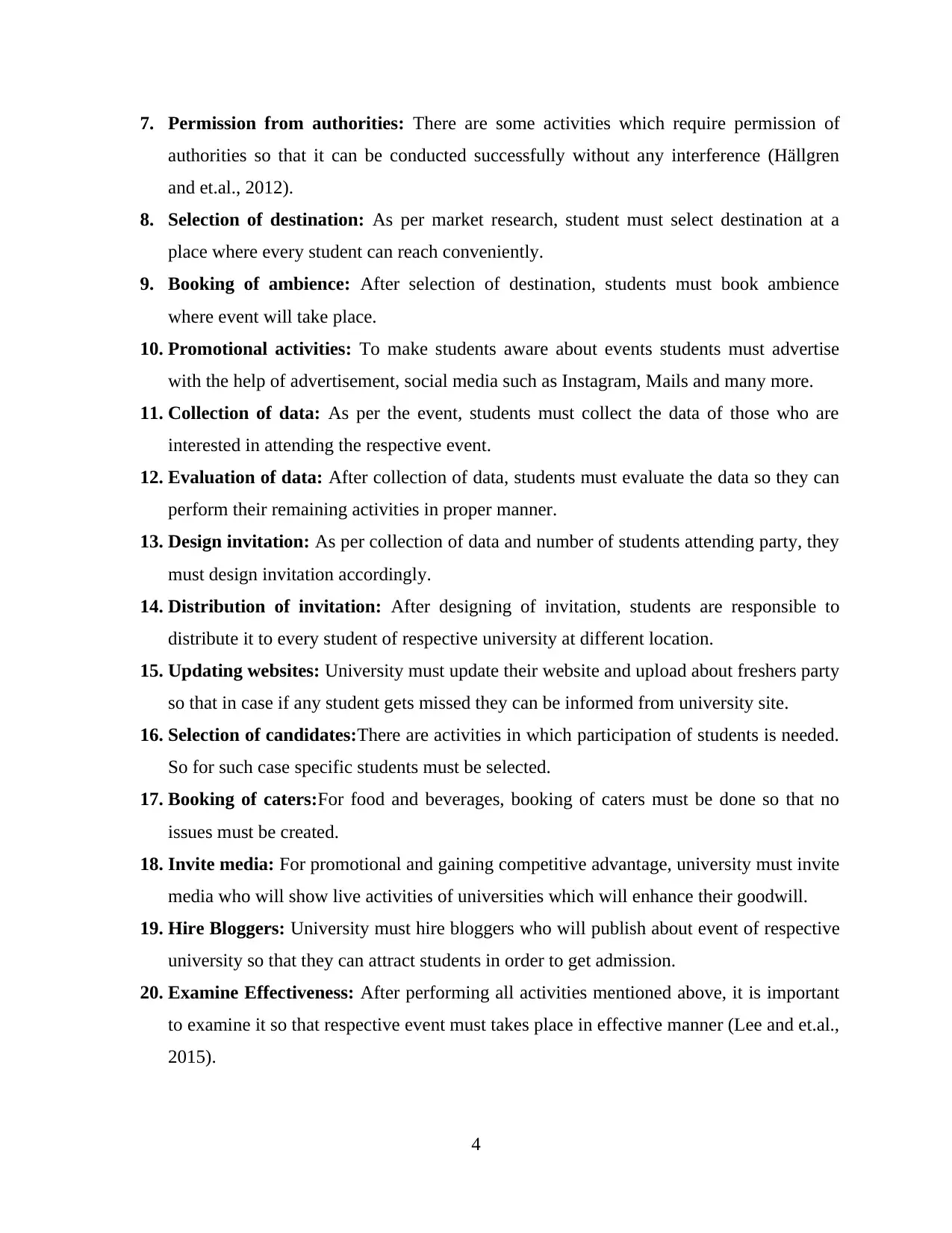
7. Permission from authorities: There are some activities which require permission of
authorities so that it can be conducted successfully without any interference (Hällgren
and et.al., 2012).
8. Selection of destination: As per market research, student must select destination at a
place where every student can reach conveniently.
9. Booking of ambience: After selection of destination, students must book ambience
where event will take place.
10. Promotional activities: To make students aware about events students must advertise
with the help of advertisement, social media such as Instagram, Mails and many more.
11. Collection of data: As per the event, students must collect the data of those who are
interested in attending the respective event.
12. Evaluation of data: After collection of data, students must evaluate the data so they can
perform their remaining activities in proper manner.
13. Design invitation: As per collection of data and number of students attending party, they
must design invitation accordingly.
14. Distribution of invitation: After designing of invitation, students are responsible to
distribute it to every student of respective university at different location.
15. Updating websites: University must update their website and upload about freshers party
so that in case if any student gets missed they can be informed from university site.
16. Selection of candidates:There are activities in which participation of students is needed.
So for such case specific students must be selected.
17. Booking of caters:For food and beverages, booking of caters must be done so that no
issues must be created.
18. Invite media: For promotional and gaining competitive advantage, university must invite
media who will show live activities of universities which will enhance their goodwill.
19. Hire Bloggers: University must hire bloggers who will publish about event of respective
university so that they can attract students in order to get admission.
20. Examine Effectiveness: After performing all activities mentioned above, it is important
to examine it so that respective event must takes place in effective manner (Lee and et.al.,
2015).
4
authorities so that it can be conducted successfully without any interference (Hällgren
and et.al., 2012).
8. Selection of destination: As per market research, student must select destination at a
place where every student can reach conveniently.
9. Booking of ambience: After selection of destination, students must book ambience
where event will take place.
10. Promotional activities: To make students aware about events students must advertise
with the help of advertisement, social media such as Instagram, Mails and many more.
11. Collection of data: As per the event, students must collect the data of those who are
interested in attending the respective event.
12. Evaluation of data: After collection of data, students must evaluate the data so they can
perform their remaining activities in proper manner.
13. Design invitation: As per collection of data and number of students attending party, they
must design invitation accordingly.
14. Distribution of invitation: After designing of invitation, students are responsible to
distribute it to every student of respective university at different location.
15. Updating websites: University must update their website and upload about freshers party
so that in case if any student gets missed they can be informed from university site.
16. Selection of candidates:There are activities in which participation of students is needed.
So for such case specific students must be selected.
17. Booking of caters:For food and beverages, booking of caters must be done so that no
issues must be created.
18. Invite media: For promotional and gaining competitive advantage, university must invite
media who will show live activities of universities which will enhance their goodwill.
19. Hire Bloggers: University must hire bloggers who will publish about event of respective
university so that they can attract students in order to get admission.
20. Examine Effectiveness: After performing all activities mentioned above, it is important
to examine it so that respective event must takes place in effective manner (Lee and et.al.,
2015).
4
⊘ This is a preview!⊘
Do you want full access?
Subscribe today to unlock all pages.

Trusted by 1+ million students worldwide
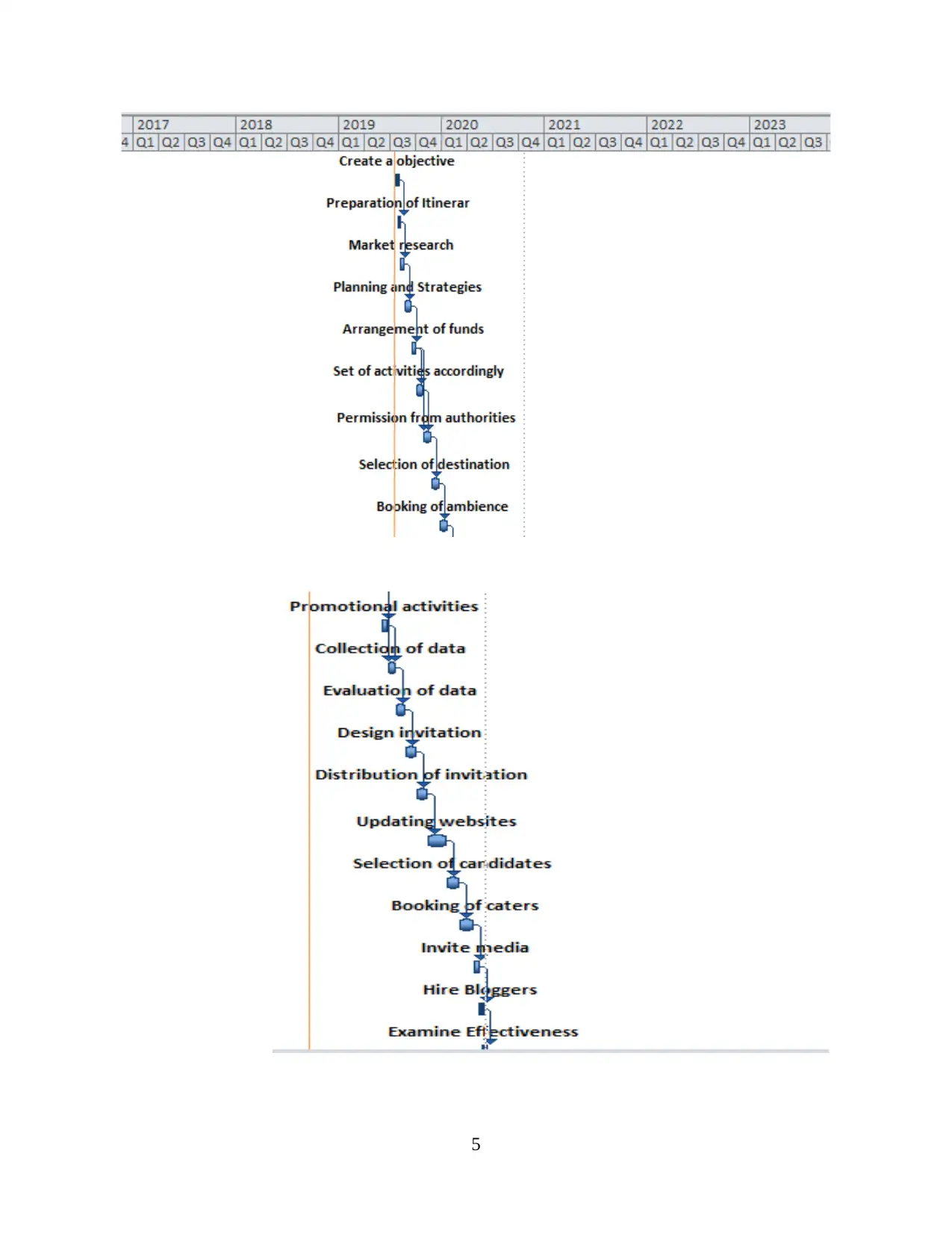
5
Paraphrase This Document
Need a fresh take? Get an instant paraphrase of this document with our AI Paraphraser
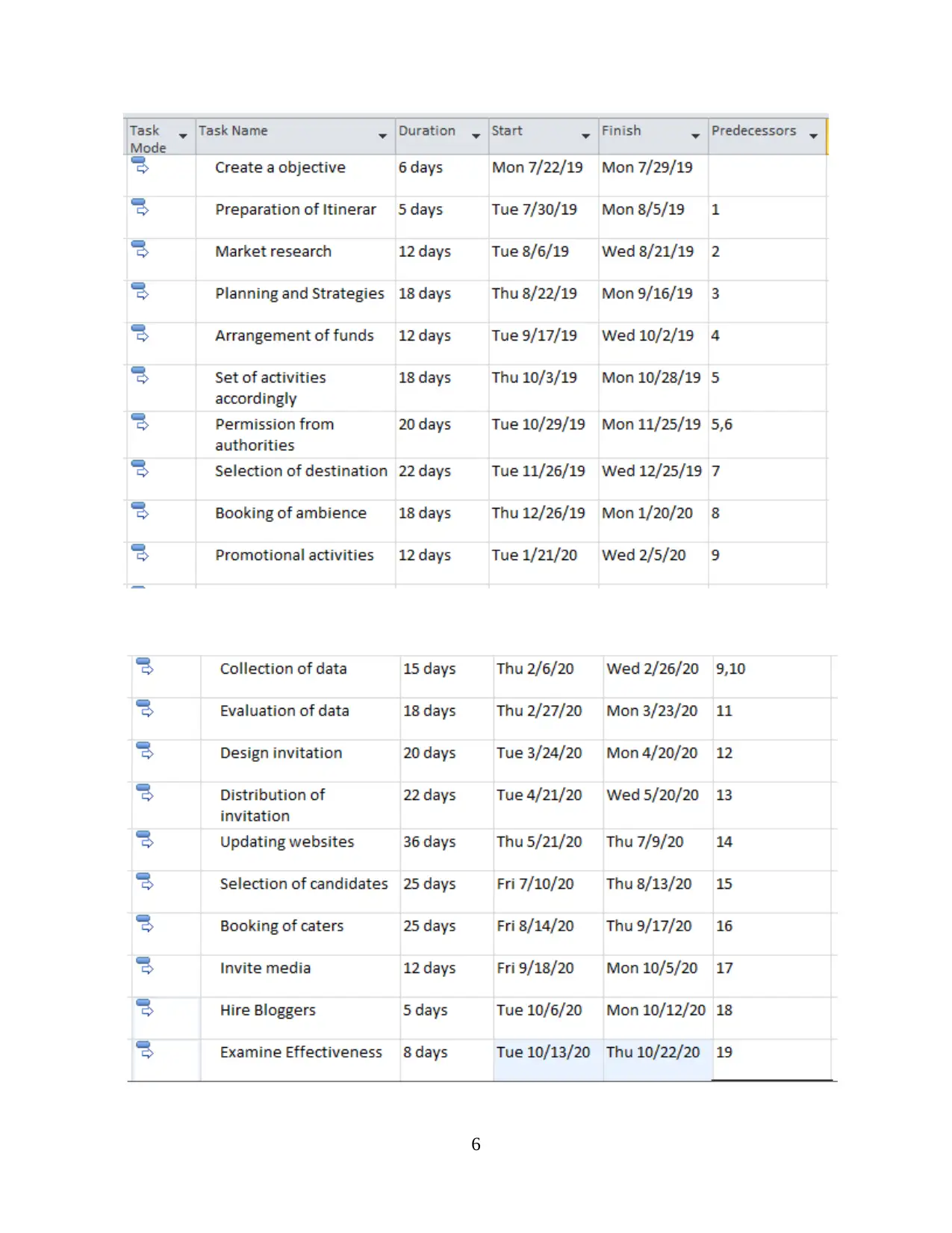
6
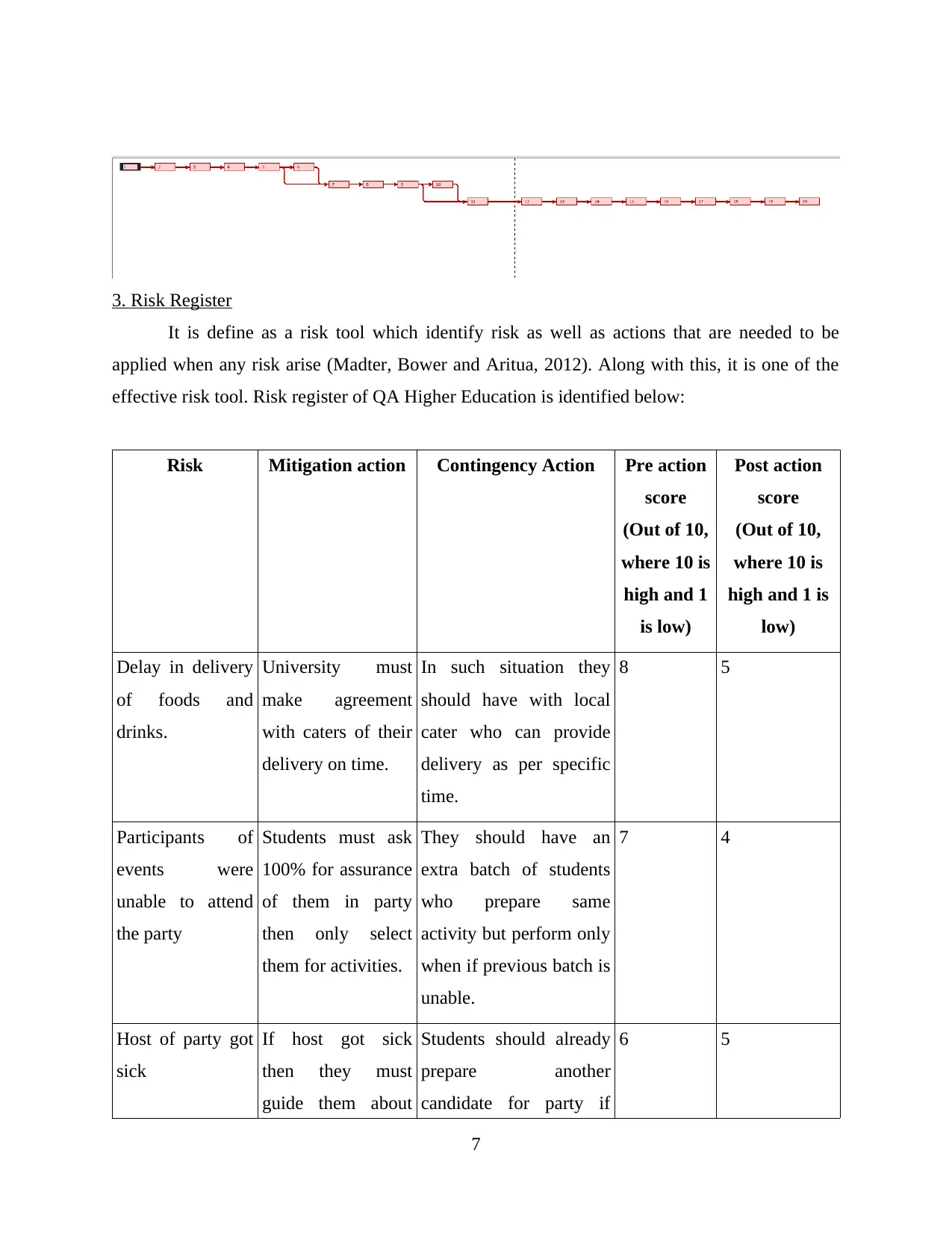
3. Risk Register
It is define as a risk tool which identify risk as well as actions that are needed to be
applied when any risk arise (Madter, Bower and Aritua, 2012). Along with this, it is one of the
effective risk tool. Risk register of QA Higher Education is identified below:
Risk Mitigation action Contingency Action Pre action
score
(Out of 10,
where 10 is
high and 1
is low)
Post action
score
(Out of 10,
where 10 is
high and 1 is
low)
Delay in delivery
of foods and
drinks.
University must
make agreement
with caters of their
delivery on time.
In such situation they
should have with local
cater who can provide
delivery as per specific
time.
8 5
Participants of
events were
unable to attend
the party
Students must ask
100% for assurance
of them in party
then only select
them for activities.
They should have an
extra batch of students
who prepare same
activity but perform only
when if previous batch is
unable.
7 4
Host of party got
sick
If host got sick
then they must
guide them about
Students should already
prepare another
candidate for party if
6 5
7
It is define as a risk tool which identify risk as well as actions that are needed to be
applied when any risk arise (Madter, Bower and Aritua, 2012). Along with this, it is one of the
effective risk tool. Risk register of QA Higher Education is identified below:
Risk Mitigation action Contingency Action Pre action
score
(Out of 10,
where 10 is
high and 1
is low)
Post action
score
(Out of 10,
where 10 is
high and 1 is
low)
Delay in delivery
of foods and
drinks.
University must
make agreement
with caters of their
delivery on time.
In such situation they
should have with local
cater who can provide
delivery as per specific
time.
8 5
Participants of
events were
unable to attend
the party
Students must ask
100% for assurance
of them in party
then only select
them for activities.
They should have an
extra batch of students
who prepare same
activity but perform only
when if previous batch is
unable.
7 4
Host of party got
sick
If host got sick
then they must
guide them about
Students should already
prepare another
candidate for party if
6 5
7
⊘ This is a preview!⊘
Do you want full access?
Subscribe today to unlock all pages.

Trusted by 1+ million students worldwide
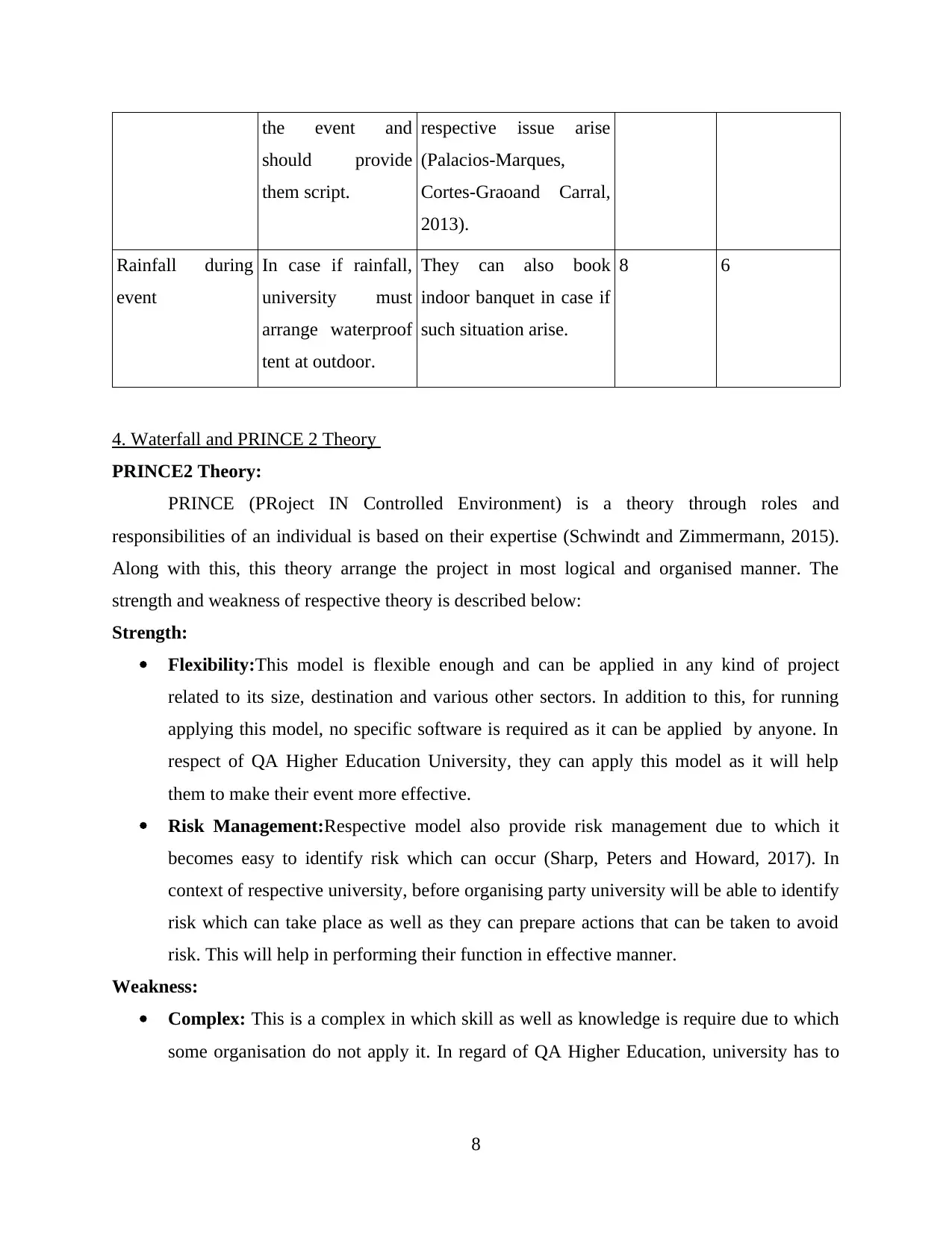
the event and
should provide
them script.
respective issue arise
(Palacios-Marques,
Cortes-Graoand Carral,
2013).
Rainfall during
event
In case if rainfall,
university must
arrange waterproof
tent at outdoor.
They can also book
indoor banquet in case if
such situation arise.
8 6
4. Waterfall and PRINCE 2 Theory
PRINCE2 Theory:
PRINCE (PRoject IN Controlled Environment) is a theory through roles and
responsibilities of an individual is based on their expertise (Schwindt and Zimmermann, 2015).
Along with this, this theory arrange the project in most logical and organised manner. The
strength and weakness of respective theory is described below:
Strength:
Flexibility:This model is flexible enough and can be applied in any kind of project
related to its size, destination and various other sectors. In addition to this, for running
applying this model, no specific software is required as it can be applied by anyone. In
respect of QA Higher Education University, they can apply this model as it will help
them to make their event more effective.
Risk Management:Respective model also provide risk management due to which it
becomes easy to identify risk which can occur (Sharp, Peters and Howard, 2017). In
context of respective university, before organising party university will be able to identify
risk which can take place as well as they can prepare actions that can be taken to avoid
risk. This will help in performing their function in effective manner.
Weakness:
Complex: This is a complex in which skill as well as knowledge is require due to which
some organisation do not apply it. In regard of QA Higher Education, university has to
8
should provide
them script.
respective issue arise
(Palacios-Marques,
Cortes-Graoand Carral,
2013).
Rainfall during
event
In case if rainfall,
university must
arrange waterproof
tent at outdoor.
They can also book
indoor banquet in case if
such situation arise.
8 6
4. Waterfall and PRINCE 2 Theory
PRINCE2 Theory:
PRINCE (PRoject IN Controlled Environment) is a theory through roles and
responsibilities of an individual is based on their expertise (Schwindt and Zimmermann, 2015).
Along with this, this theory arrange the project in most logical and organised manner. The
strength and weakness of respective theory is described below:
Strength:
Flexibility:This model is flexible enough and can be applied in any kind of project
related to its size, destination and various other sectors. In addition to this, for running
applying this model, no specific software is required as it can be applied by anyone. In
respect of QA Higher Education University, they can apply this model as it will help
them to make their event more effective.
Risk Management:Respective model also provide risk management due to which it
becomes easy to identify risk which can occur (Sharp, Peters and Howard, 2017). In
context of respective university, before organising party university will be able to identify
risk which can take place as well as they can prepare actions that can be taken to avoid
risk. This will help in performing their function in effective manner.
Weakness:
Complex: This is a complex in which skill as well as knowledge is require due to which
some organisation do not apply it. In regard of QA Higher Education, university has to
8
Paraphrase This Document
Need a fresh take? Get an instant paraphrase of this document with our AI Paraphraser
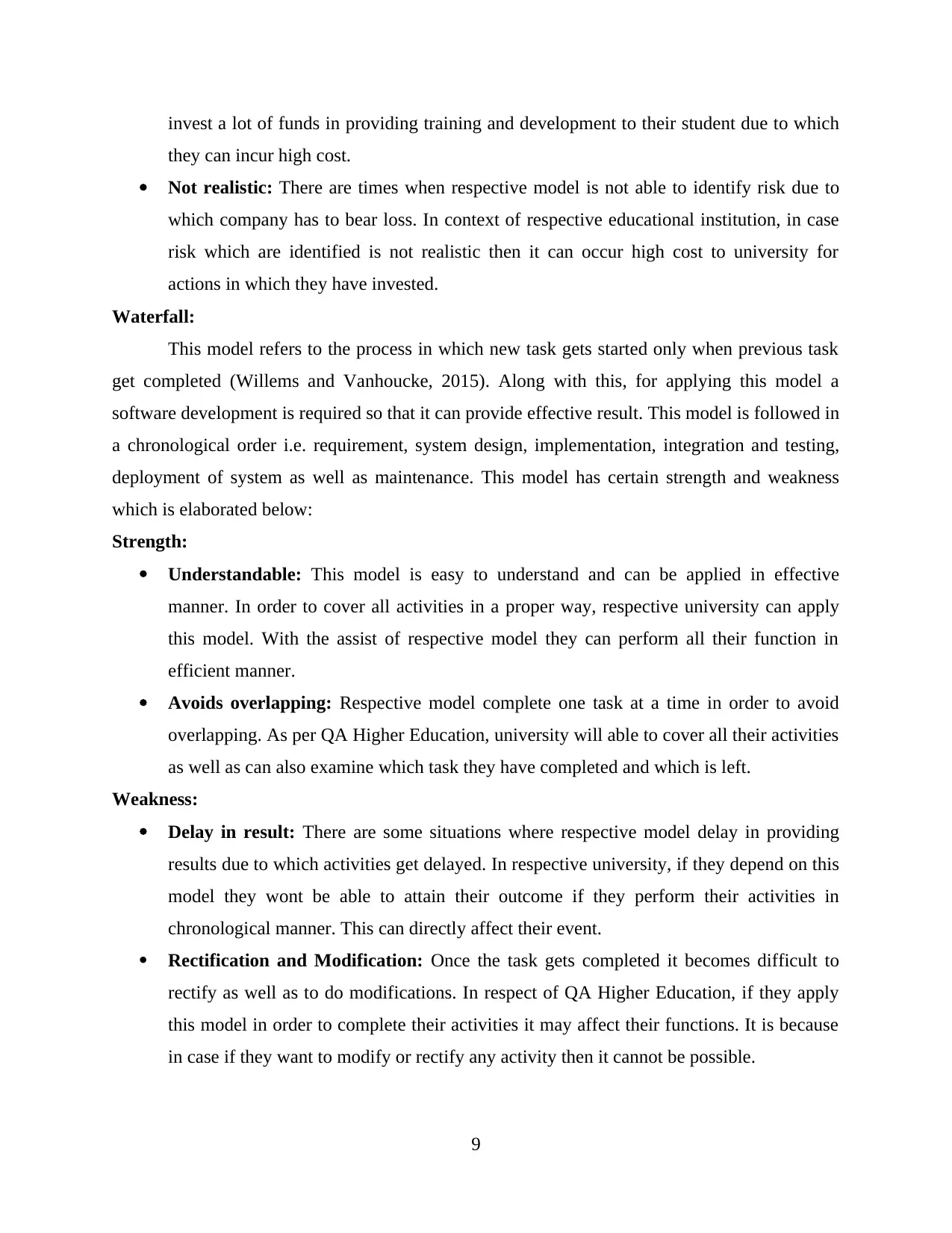
invest a lot of funds in providing training and development to their student due to which
they can incur high cost.
Not realistic: There are times when respective model is not able to identify risk due to
which company has to bear loss. In context of respective educational institution, in case
risk which are identified is not realistic then it can occur high cost to university for
actions in which they have invested.
Waterfall:
This model refers to the process in which new task gets started only when previous task
get completed (Willems and Vanhoucke, 2015). Along with this, for applying this model a
software development is required so that it can provide effective result. This model is followed in
a chronological order i.e. requirement, system design, implementation, integration and testing,
deployment of system as well as maintenance. This model has certain strength and weakness
which is elaborated below:
Strength:
Understandable: This model is easy to understand and can be applied in effective
manner. In order to cover all activities in a proper way, respective university can apply
this model. With the assist of respective model they can perform all their function in
efficient manner.
Avoids overlapping: Respective model complete one task at a time in order to avoid
overlapping. As per QA Higher Education, university will able to cover all their activities
as well as can also examine which task they have completed and which is left.
Weakness:
Delay in result: There are some situations where respective model delay in providing
results due to which activities get delayed. In respective university, if they depend on this
model they wont be able to attain their outcome if they perform their activities in
chronological manner. This can directly affect their event.
Rectification and Modification: Once the task gets completed it becomes difficult to
rectify as well as to do modifications. In respect of QA Higher Education, if they apply
this model in order to complete their activities it may affect their functions. It is because
in case if they want to modify or rectify any activity then it cannot be possible.
9
they can incur high cost.
Not realistic: There are times when respective model is not able to identify risk due to
which company has to bear loss. In context of respective educational institution, in case
risk which are identified is not realistic then it can occur high cost to university for
actions in which they have invested.
Waterfall:
This model refers to the process in which new task gets started only when previous task
get completed (Willems and Vanhoucke, 2015). Along with this, for applying this model a
software development is required so that it can provide effective result. This model is followed in
a chronological order i.e. requirement, system design, implementation, integration and testing,
deployment of system as well as maintenance. This model has certain strength and weakness
which is elaborated below:
Strength:
Understandable: This model is easy to understand and can be applied in effective
manner. In order to cover all activities in a proper way, respective university can apply
this model. With the assist of respective model they can perform all their function in
efficient manner.
Avoids overlapping: Respective model complete one task at a time in order to avoid
overlapping. As per QA Higher Education, university will able to cover all their activities
as well as can also examine which task they have completed and which is left.
Weakness:
Delay in result: There are some situations where respective model delay in providing
results due to which activities get delayed. In respective university, if they depend on this
model they wont be able to attain their outcome if they perform their activities in
chronological manner. This can directly affect their event.
Rectification and Modification: Once the task gets completed it becomes difficult to
rectify as well as to do modifications. In respect of QA Higher Education, if they apply
this model in order to complete their activities it may affect their functions. It is because
in case if they want to modify or rectify any activity then it cannot be possible.
9
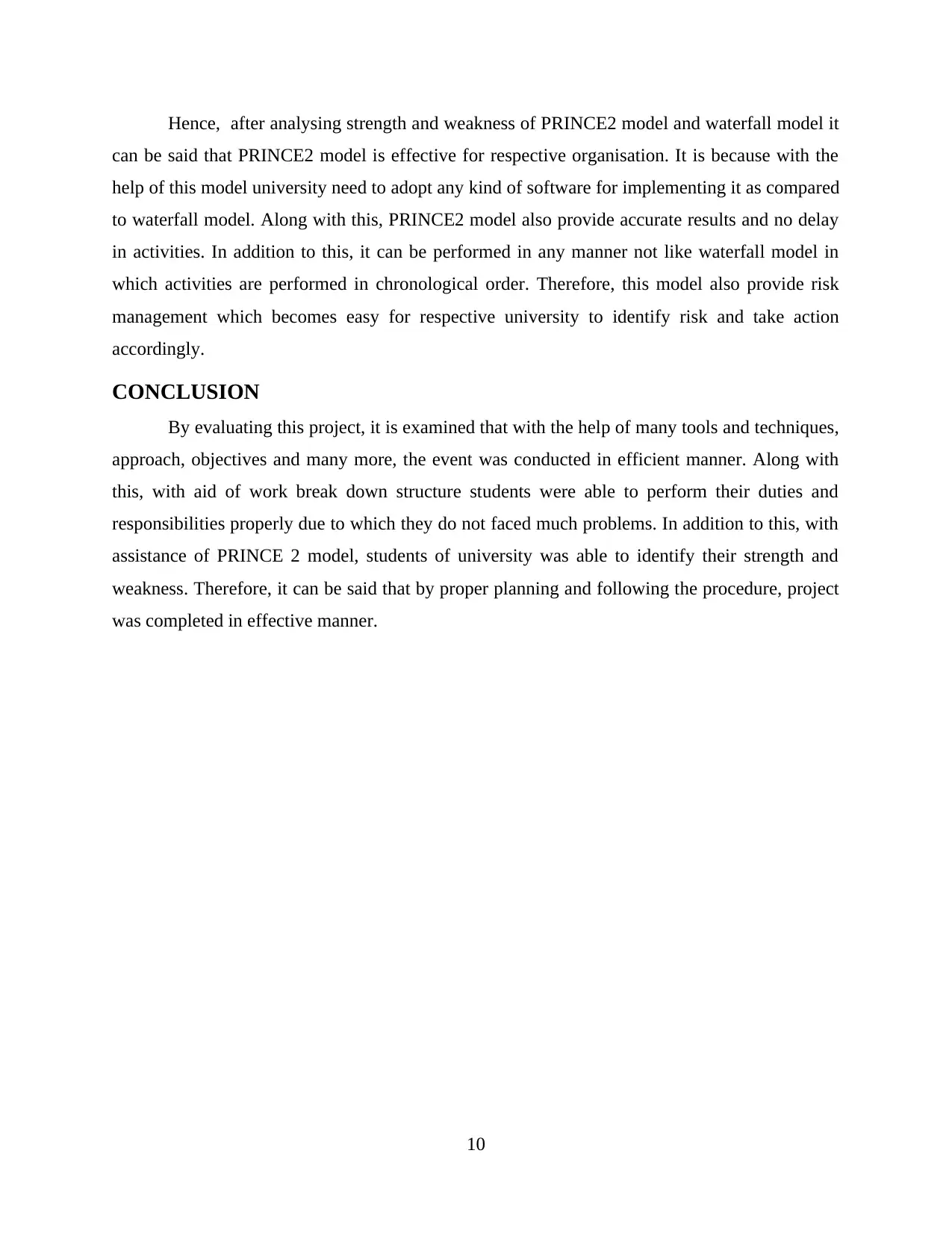
Hence, after analysing strength and weakness of PRINCE2 model and waterfall model it
can be said that PRINCE2 model is effective for respective organisation. It is because with the
help of this model university need to adopt any kind of software for implementing it as compared
to waterfall model. Along with this, PRINCE2 model also provide accurate results and no delay
in activities. In addition to this, it can be performed in any manner not like waterfall model in
which activities are performed in chronological order. Therefore, this model also provide risk
management which becomes easy for respective university to identify risk and take action
accordingly.
CONCLUSION
By evaluating this project, it is examined that with the help of many tools and techniques,
approach, objectives and many more, the event was conducted in efficient manner. Along with
this, with aid of work break down structure students were able to perform their duties and
responsibilities properly due to which they do not faced much problems. In addition to this, with
assistance of PRINCE 2 model, students of university was able to identify their strength and
weakness. Therefore, it can be said that by proper planning and following the procedure, project
was completed in effective manner.
10
can be said that PRINCE2 model is effective for respective organisation. It is because with the
help of this model university need to adopt any kind of software for implementing it as compared
to waterfall model. Along with this, PRINCE2 model also provide accurate results and no delay
in activities. In addition to this, it can be performed in any manner not like waterfall model in
which activities are performed in chronological order. Therefore, this model also provide risk
management which becomes easy for respective university to identify risk and take action
accordingly.
CONCLUSION
By evaluating this project, it is examined that with the help of many tools and techniques,
approach, objectives and many more, the event was conducted in efficient manner. Along with
this, with aid of work break down structure students were able to perform their duties and
responsibilities properly due to which they do not faced much problems. In addition to this, with
assistance of PRINCE 2 model, students of university was able to identify their strength and
weakness. Therefore, it can be said that by proper planning and following the procedure, project
was completed in effective manner.
10
⊘ This is a preview!⊘
Do you want full access?
Subscribe today to unlock all pages.

Trusted by 1+ million students worldwide
1 out of 13
Related Documents
Your All-in-One AI-Powered Toolkit for Academic Success.
+13062052269
info@desklib.com
Available 24*7 on WhatsApp / Email
![[object Object]](/_next/static/media/star-bottom.7253800d.svg)
Unlock your academic potential
Copyright © 2020–2025 A2Z Services. All Rights Reserved. Developed and managed by ZUCOL.




